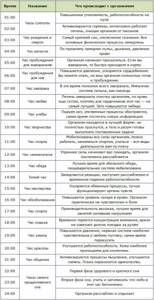Every person, and especially those losing weight, at least once in their life tried to take control of their own time. Managing it is a real art, to which a huge amount of scientific research has been devoted. Their results were time management, the Eisenhower matrix, timekeeping, and the ideas of chronophages, procrastination, and time pressure were developed. And in pursuit of a healthy lifestyle, modern people are trying to master all this. In fact, everything is much simpler, and you don’t need to be able to operate with these concepts to create a daily schedule.
We find out what a weight loss regime should be, what it includes, whether it is beneficial and whether it is possible to organize it yourself, without the involvement of specialists and all these abstruse terms.
What is mode
In the general sense of the word, a regime means a routine of actions, detailed in detail for a certain period. It can be compiled for a day, a week, a month and even a year.
If a person plans to lose weight, first of all he will have to put his life in order. This means that sleep, nutrition, training, work and rest must correspond to a clear schedule, drawn up literally by the hour.
The regime is compiled in accordance with:
- human biological rhythm;
- the chosen diet (in the English diet, for example, there is no breakfast, and in the model diet there is no dinner);
- eating habits (if a person has been eating 3 times a day since childhood, there is hardly any point in breaking this tradition by switching to fractional meals);
- work schedule (shifts, lunch breaks, number of working hours per day are taken into account);
- individual training plan;
- interests, hobbies.
For all these moments, specific time should be allocated, and the regime for those losing weight will differ from the daily schedule of an ordinary person. It is compiled taking into account the rules prescribed by nutritionists, fitness trainers and endocrinologists. After all, its task is to force the body to work so that not a trace remains of excess weight. But how is this possible?
Educational program. To create the right regime, you still have to get acquainted with your own chronophages in order to get rid of them once and for all. These are “time wasters” that prevent you from getting everything done. Each person has their own. This could be chronic illnesses, a messy room or workplace, the inability to say “no”, social networks, unnecessary conversations on the phone, outdated relationships and much more.
Can the correct daily routine for losing weight be individual?
Modern medicine does not adhere to the point of view that a healthy adult must get up at a certain time, certainly early in the morning, and squeeze training into his morning routine. The problem with the daily routine is most often that we confuse general hygiene recommendations, which are mandatory for everyone, and someone’s specific daily routine, which we try to copy, despite the individual characteristics of work and health.
So, general recommendations for the daily routine are:
- you need to sleep 7-8 hours every night, and not 20 hours on the night from Friday to Saturday, and 3 hours on weekdays;
- Going to bed should occur at approximately the same time, and the same applies to waking up. In general, our “oversleeping” on weekends, of course, does not harm our health, but it disrupts our eating schedule, which can negatively affect diet adherence;
- Meals should occur at the same time. Moreover, fractional meals, which they often try to impose on everyone without taking into account the characteristics of eating behavior, are completely unnecessary. You can eat from 3 to 6 times a day, just be sure to eat at a strictly defined (same) time;
- the workout should also be time-bound. Moreover, it is better not to “push” it forcefully in the morning or evening, because “everyone does it, and some article says so,” but to do it when you feel physically well.
Why is it needed?
Many people do not understand how a daily routine contributes to weight loss. Will an hourly schedule of tasks help you burn fat? In fact, the benefits of a proper schedule of eating and sleeping, work and rest have long been scientifically proven. It eliminates the main causes of excess weight - that’s the whole secret.
You can't lose weight because...
...overeat
Did you empty the refrigerator again last night? Think about why your body asks you to eat before bed. Perhaps because he didn't have enough resources during the day? Coffee for breakfast, fast food for lunch, unhealthy dinner at a diner, cakes or pastries for a snack - with such nutrition it is not surprising that in the evening your appetite awakens. But it’s easy to curb it by scheduling the caloric content of each meal and defining a specific time for it.
The body is a smart and orderly system. With chaotic nutrition, he does not know when he will be given fuel next time. It is quite logical that he begins to stock up on resources for a rainy day. And if at a certain moment a meal is missed, he will always have something to spend. This is how visceral fat is formed - the culprit of a blurred waist, saggy sides, cellulite thighs and a beer belly.
Basic Rules
We study the basic recommendations of experts on how to create the right daily regimen for weight loss.
Biological rhythms
Biological rhythms depend on the individual characteristics of a person (are you a morning person or a night owl) and solar activity. Use the following table to create your schedule. It demonstrates how the body works at certain times.

Preparation stage
Don’t think that today you downloaded a ready-made weight loss regime, and from tomorrow you will start living according to it, down to the minute. To achieve results, you will have to spy on yourself for a week. Follow the recommendations of experts:
- Study the information on creating the right daily routine.
- Write down on a piece of paper all the activities that made up your typical day before.
- Cross out everything that interferes with weight loss (trips to fast food establishments, evening gatherings in front of the TV, etc.).
- Write down what you plan to use for weight loss (5 meals a day, exercise, walking).
- For a week, next to each planned action, write down the time you spent on it.
- At the end of the week, calculate the arithmetic average of how many minutes (hours) it takes to complete a particular event.
- Cross out what you couldn’t find time for during the week, even if you originally planned to do it.
Only after this can you schedule a routine hourly and begin to implement it. Don’t forget to make it in several copies: for weekdays, holidays and weekends.
Set of general recommendations
The daily routine should be recorded on paper or electronic media.
Constantly check your every action with it. In the evening, analyze what percentage of the plan you fulfilled, what didn’t work out and why. Adjust it accordingly.
Try to gradually accustom your family to your schedule. You must live with them in the same regime. If the husband sits in front of the TV until late, the wife is unlikely to be able to organize proper sleep, without which weight loss is impossible.

If you feel that some point of the planned plan is difficult, feel free to cross it out, but take note. Perhaps in a couple of months you will be ready to add it to your schedule.
Don't forget about pleasure. Without them, your motivation will wane by the end of the week. Work should alternate with rest. You should get at least 7-8 hours of sleep, and you should try to go to bed before midnight.
As a consolation to everyone losing weight: it will be incredibly difficult to adjust in the first 3 weeks. However, according to scientists, on the 21st day a person develops a habit, and you will begin to do many actions almost automatically.
Article on physical education on the topic: "Daily routine and its importance for health"
Daily routine and its importance for human health, organization of the daily routine.
Today, people continue to think that health is as constant as electricity and water supply, that it will always be there, because... modernity has shifted the care of it onto the shoulders of the state and the medical industry, which must supply health as products, goods, and services. Man has become a consumer, not a producer of his health.
Despite the ever-expanding scope of medical care, its large-scale measures include the desire for universal medical examination, mass forms of physical education, an increase in the number of medical personnel, clinics, hospitals, and finally, resorts, holiday homes, etc. – the number of people with health problems is not decreasing. Both environmental pollution and high levels of human stress play a significant role in this. However, it is well known that the main and most serious reason is an irrational lifestyle, suboptimal use of today's achievements in the sciences of man, his reserves, psychophysiological and physical capabilities. Human health depends on:
— state of medicine – by 10%;
— influence of environmental factors – by 20-25%;
— genetic factors – by 20%;
— conditions and lifestyle – by 50%.

A healthy lifestyle refers to the forms of daily life used that comply with hygienic principles, enhance the adaptive capabilities of the human body, contribute to the restoration, maintenance and development of its reserve levels, as well as the performance of professional functions.
One of the factors influencing the average life expectancy of a person is the level of culture and well-being of society, and physical culture is part of the general culture.
Working muscles and musculature form a flow of impulses that constantly stimulates metabolism, the activity of the nervous system and all organs, which, of course, improves the use of oxygen by tissues, excess fat is not deposited, and the protective properties of the body are increased. Physical inactivity and limited physical activity intensively contribute to the attenuation of the body’s vital functions.
It is necessary to learn to follow a daily routine. This concept includes the following points:
1) sufficient and complete sleep with strictly established times of getting up and going to bed;
2) rational nutrition at the same hours;
3) a certain time for preparing homework, outdoor recreation, physical exercise, free activities and helping the family.

The absence of a clear, strictly observed regimen has the most unfavorable effect on the body. Efficiency decreases, academic performance decreases, and over time, signs of health problems appear. A strict, rhythmic regime of work and rest is one of the most important conditions for high performance of the human body. In this case, it is necessary to take into account the differences in living and working conditions of individual categories of people whose work is associated with different types of activities.
The basic provisions of work and rest must be observed by everyone, regardless of the specifics of the activity.
If a clear regime is observed, a certain biological rhythm of the body’s functioning is developed, i.e. a dynamic stereotype is developed in the form of a system of alternating conditioned reflexes. By becoming stronger, they make it easier for the body to carry out its work, since they create conditions and opportunities for internal physiological preparation for the upcoming activity. For example, if you engage in mental or physical labor every day, which occurs at the same hours, the body, as it were, is “brought up” to increased efficiency, i.e. to the ability to “get together.” The same thing happens with a regular diet. By the “programmed” time, an intensive release of digestive juice occurs, intestinal motility increases, which promotes and ensures effective digestion.
In this case, the absorption of nutrients is maximum, which is especially important for a growing organism.
The body's readiness for a certain time is the general important physiological basis of the daily routine. If a person goes to bed and wakes up at the same time every day, has breakfast and lunch, does morning exercises, and carries out hardening procedures, then a time reflex is developed.
The consistent repetition of these actions forms the so-called dynamic stereotype of nervous processes in the cerebral cortex. A dynamic stereotype sets a certain rhythm of life, facilitating all life processes.
If, for example, a child sits down to study at a certain time, then by this hour he has not only a psychological, but a physiological mood - breathing, blood circulation, brain activity, etc. slightly increase.

This readiness to perform mental work allows you to complete the required task faster and better. These are the biological and physiological basis of the daily routine. The state of the body depends on the oscillatory rhythmic phenomena of the external environment - changes in light and darkness, meteorological factors, changes in seasons, solar activity using the example of the earth's magnetic field.
At night, metabolic rates, the functioning of the cardiovascular and respiratory systems, and body temperature decrease. Pulse, frequency and depth of breathing decrease. The brain does not receive information, there is no physical or mental stress. The body rests and recovers. During the day, the intensity of physical activity increases, which significantly intensifies the work of the cardiorespiratory system and metabolic processes. All functions of the central nervous system and metabolic processes increase. All functions of the central nervous system and higher nervous activity increase.
A person’s performance gradually increases in the morning and reaches its highest peak at 10-13 o’clock. After 14 hours there is a decrease in performance, and at 16-17 hours there is a wave of increase in all functions. A decline in functionality is usually observed after 20 hours. Do individual characteristics of the body or social factors influence the mode of work and rest? Undoubtedly. These factors cannot be ignored, but its main provisions must be observed. These include simple but necessary requirements:
- performing various types of activities strictly at a certain time;
— rational alternation of work and rest;
- regular and nutritious meals, at least 3 times a day and at the same hours;
— targeted motor (physical) activity, at least 6 hours a week;
- stay in clean air for at least 2-3 hours a day;
- strict adherence to sleep hygiene, at least 8 hours a day, preferably sleeping at night at the same time.
A brief description of the characteristics of the human body during the day:
1 am. 76% of people have been sleeping for about three hours, having gone through all stages of sleep. Its mild phase has arrived, a person can easily awaken. It is at this moment that we are especially sensitive to pain.
2 hours. Most of our organs work economically, with the exception of the liver. She uses these quiet moments to work more intensively with the substances a person needs. And, above all, with those that remove all poisons from the body. The body undergoes a kind of “big wash”. If you are not sleeping at this time, you should not drink coffee, tea, and especially alcohol. It is best to drink a glass of water or milk.
3 hours. The body is resting. Physically we are completely exhausted. If you have to stay awake, try to concentrate completely on the work that needs to be completed. At this time, our blood pressure is lowest, pulse and breathing are slowest.
4 hours. Breathing is still low, the brain is supplied with a minimal amount of blood. This is the hour when people most often die. The body “works” at the lowest “speed”, but the hearing becomes more acute. We wake up at the slightest noise.
5 o'clock. The kidneys do not secrete anything. We have already changed several phases of sleep. Anyone who gets up at this time quickly comes to a cheerful state.
6 hours. The pressure rises, the heart beats faster, the blood pulsates in the veins. Even if we want to sleep, our body is already awakening.
7 o'clock. Human immunological defense is especially strong. Whoever comes into conflict with viruses and bacteria at this hour has a greater chance of winning.
8 ocloc'k. The body was rested, the liver freed our body from toxic substances. At this time, under no circumstances should you drink alcohol - the liver will be under a lot of stress.
9 o'clock. Mental activity increases, sensitivity to pain decreases. The heart is working at full capacity.
10 hours. Activity increases. We are in the best shape. Anyone who is sitting at this time over a cup of coffee or chatting about trifles is simply dissipating their efficiency, which will no longer manifest itself in full force.
11 o'clock. The heart continues to work rhythmically, in harmony with our mental activity. Large loads are almost not felt.
12 hours. The moment comes to mobilize all forces. You should not eat a large meal now - it is better to have lunch an hour later.
13 hours. The liver rests, and some glycogen enters the blood. The first period of daytime activity has passed, you feel tired, although there is still a lot of work ahead. Need rest.
14 hours. The energy curve drops. This is the second lowest point in the 24-hour cycle. Reactions slow down.
15 hours. Things are getting better again. The senses, especially smell and taste, are heightened to the limit. (Gourmets, by the way, prefer to sit down at the table at this time.) We are returning to normal again.
16 hours. Blood sugar levels rise. However, this is not a disease. After the initial recovery, a decline sets in.
17 o'clock. Productivity is still high. Athletes train with renewed energy.
18 hours. People's sense of physical pain decreases again. The desire to move more increases. Mental alertness gradually decreases.
7 p.m. Blood pressure rises, mental stability is at zero. We are nervous, we can quarrel over a trifle. Bad time for allergy sufferers. Headaches begin.
20 o'clock. At this hour, your weight reaches its maximum, your reactions are amazingly fast. The drivers are in excellent shape, there are almost no accidents.
21 o'clock Mental state is normal. Evening memory becomes more acute.
22 hours. The blood is saturated with blood cells - the number of leukocytes doubles. Body temperature decreases.
11 p.m. Our body is already preparing for rest, continuing to work on cell restoration.
00 o'clock. If we went to bed at 10 pm, it is time to dream. Not only the body, but also the brain takes stock, rejecting everything unnecessary. The day is over.
Physical education plays an extremely important role in the development of a person’s spiritual and physical strength and in strengthening his health. The function of movement is the main biological function of any living organism, the main stimulator of the processes of growth and formation of a young organism. In old age, physical movement is a factor that counteracts premature aging of the body.
Physical culture and sports develop in the human body the ability to adapt to sudden and strong functional fluctuations, as well as the body’s enormous endurance in the event of prolonged, chronic exposure to unfavorable conditions.
When muscles work, certain chemical reactions occur. Acetylcholine is formed in the muscle, which increases the permeability of cell membranes for sodium, potassium, magnesium ions and other nutrients and substances necessary for cells. Thus, muscle activity is a positive factor influencing many body functions through nerve centers and blood. Systematic physical activity has a positive effect on a person. The heart, even at rest, begins to work economically, the rhythm of its contractions slows down, but their strength increases and more blood is released per beat.
The safety margin of the heart increases. Blood vessels become more elastic, and blood pressure is maintained at the level characteristic of a young person. Breathing slows down but becomes deeper. The supply of oxygen to the body and especially the brain improves, which is facilitated by an increase in the number of red blood cells and an increase in the amount of hemoglobin in the blood. Under the influence of physical exercise, especially exercise that develops strength, bones become larger, stronger and heavier, richer in calcium.
Joints and ligaments also function better in people involved in physical activity and sports. Under the influence of physical exercises, vision also improves. Physical activity is one of the most important components of a person’s healthy lifestyle, which is based on the reasonable, gender-, age-, and health-appropriate, systematic use of physical exercise and sports.
Nutrition is the process of consuming and utilizing food for the growth, restoration and functioning of the body. The human body needs more than 40 essential nutrients, which it cannot provide itself and therefore must receive them from the outside.

A person's nutritional needs are often determined by his hereditary characteristics. Therefore, the set of components of one person’s diet may not be suitable for another. What matters is not what we eat, but how much we eat, when we eat and in what combination we eat certain foods. Proper nutrition allows the body to maximize its genetic potential.
The selection of food products is based on the fact that the body must receive a sufficient amount of fats, proteins, carbohydrates, vitamins, mineral salts, and water. It is believed that the daily protein intake should be on average 100 g, fat - 80-90 g, carbohydrates - 350-400 g.
An important principle of rational nutrition is the balance of essential nutrients. The ratio of proteins-fat-carbohydrates should be 15-30-55% of the daily calorie intake of food, respectively. Proteins of animal origin (meat, fish, cheese, milk, poultry) should make up 50-60% of his daily requirement, and half of this amount should be provided by dairy products. Vegetable proteins (soybeans, buckwheat and oatmeal, beans, peas, beans) make up 40% of the norm.[1] The main purpose of proteins is that they serve as a building material, partially cover the body’s energy expenditure, and stimulate mental activity. Fats (animal and vegetable) are the main energy material. When digested, they provide twice as many calories as proteins and carbohydrates combined. In the daily diet, it is advisable to distribute fats in the following way: one quarter is butter, the other is vegetable oil, the remaining half should be provided by fat used for culinary purposes.
Carbohydrates (simple and complex) are also energy suppliers. They are quickly absorbed by the blood and are used for work and recovery after physical or mental stress. The ability of carbohydrates to be stored as fat requires reasonable restrictions from a person. It is recommended that sugar account for no more than 20% of carbohydrates in the daily diet.
It is important that at least 30% of the total amount of carbohydrates is provided by carbohydrates from vegetables and fruits. Mineral salts take part in all types of metabolism in the body.
The most important for the normal development and functioning of the body are calcium, phosphorus, magnesium, iron, potassium and others.
Vitamins are organic compounds with great biological activity. They are necessary for normal growth and repair of cells and tissues. In the absence or deficiency of several vitamins in food, serious diseases - vitamin deficiencies - can occur. All vitamins are divided into two groups: water-soluble (C, P, B vitamins) and fat-soluble (A.D.E.K). Water, which makes up 66% of body weight, is involved in all processes occurring in the body. The daily fluid intake, taking into account the vegetables and fruits eaten, is up to 2.5 liters, i.e. as much as it is excreted from the body per day, which ensures water balance.
When a person is young and healthy, he pays the least attention to maintaining his health. Health at any age can be judged by the body’s ability to function normally in the external environment and when it changes, and to maintain working capacity.
Sleep is an effective way to relieve mental and physical stress. This is a physiological defense of the body; the need, like treatment, is determined by complex psychophysiological processes.
During sleep, changes occur in the entire vital activity of the body, energy consumption decreases, systems that have suffered overload (overwork or painful changes) are restored and begin to function. Energy-rich phosphorus compounds accumulate, and the body's defenses increase. Chronic lack of sleep contributes to the appearance of neuroses, deterioration of functionality and a decrease in the body's defenses.
Sleep hygiene involves going to bed and getting up at the same time or with a slight time difference. Silence, darkened windows, an influx of fresh air, but not a draft, are required. Eating food that does not stimulate the body is 1.5-2 hours before bedtime. It is advisable to focus on relaxation, without burdening yourself with thoughts, worries and experiences of the past day and the future.
A healthy lifestyle is the main factor in human health, but you have to fight for it, overcoming your inertia, laziness, gluttony, and weakness of will. However, you cannot adhere to a healthy lifestyle without knowing what it is, what its content and principles are. In our country, the introduction of a healthy lifestyle is slow and with minimal effect. In addition to others, a negative role here is played by such factors as the lack of traditions of a healthy lifestyle in society, the prevailing way of life, in which the attitude towards people’s health is considered as a component of production relations. At present, we cannot yet fully control biological rhythms; this is a matter for the future. But even now, a significant part of hygiene recommendations is based on knowledge of the rhythmic activity of the body and, first of all, on the so-called circadian or daily rhythms.
Scientists have found that dozens of processes occurring in the human body are subject to a circadian rhythm. During the daytime, those parts of the autonomic nervous system that provide the body with the most favorable opportunities for physical and mental work are most active. And, as you know, a person performs his main activity during the day.
Thus, the daily routine with all its components is an interesting topic not only from a practical, but also from a scientific point of view.
Nutrition
To create a healthy diet, consider the following tips:
- Leave diet as a last resort. Start by practicing healthy eating. Remember: hunger will force the body to store fats in reserve.
- Meals should be fractional - at least 5 times. However, if you have been accustomed to eating three times a day since childhood, do not change your schedule.
- Don't overeat. The menu indicates the serving sizes that you must adhere to.
- Do not skip a single meal prescribed in the schedule.
- The time lag from the plan points should be no more than half an hour.
- Calculate the daily caloric intake required for weight loss (formulas with examples, recommendations, see the link). Study the issue of the ratio of BZHU. Take all this into account when creating your menu.
- Avoid harmful foods. Sweets - in the first half of the day, proteins - in the second.
Drinking regime

To lose weight, you need to properly organize your water drinking regimen, which normalizes your metabolism. Several rules also apply here:
- To avoid dehydration, avoid coffee, smoking and alcohol.
- The water should be slightly chilled.
- Protein-based nutrition systems require more water.
- Water should be drunk an hour before and the same time after meals.
- You need to start your day with a glass of water.
- The daily norm is 2-2.5 liters.
Approximate hourly schedule:

Workout
A huge mistake many people make when losing weight is that, trying to burn as many calories as possible, they exhaust themselves with daily workouts. The result is sore throat, overtraining, exhaustion due to low calorie intake, and loss of strength. Accordingly, after a week there can be no question of any sports activities. Experienced people know that after a stressful load, muscles need to be allowed to recover. Therefore, fitness trainers recommend exercising only 3 times a week, and on a 24-hour basis (+ 2 full days off at the end of the week).
Training time is from 40 minutes to 1 hour. If you are a beginner, you can start with 15-20 minutes, gradually increasing the load. You shouldn't exercise for more than an hour: you're losing weight, not gaining muscle mass.
When creating a training regimen, keep in mind that to lose weight you need to be able to correctly combine strength and cardio exercises: start with the former and finish with the latter (we have also already discussed this point in detail). Then the fat burning process will be more intense.
A daily routine is extremely important in the process of losing weight; it allows you to simultaneously improve your health and organize your own life. If you starve and spend several hours every day in the gym, you will only harm your body.
Individual motor regimen of the day
When starting regular physical education, you don’t need to limit yourself to a narrow choice of means.
.
To achieve improved health, it is not enough to perform any one physical exercise
or even engage in one sport: for example, doing only morning exercises or just jogging or walking. In the first case, insignificant physical activity will not give a complete healing effect, in the second - a one-sided load on the cardiovascular and respiratory systems produces a valuable, but only one quality - endurance. A person needs all-round physical development and must develop all the physical qualities necessary for life - strength, speed, endurance, agility. That is why physical exercises should be as varied in nature as possible. You need to study according to a certain system. Anyone who regularly engages in physical education is recommended to establish an optimal individual motor regimen for the day, week, year and, if possible, try to adhere to it.
Motor regime of a healthy person's day
should be something like this: in the morning after sleep,
exercise is required
. Its content, depending on age, habits, health status and other reasons, is strictly individual. This can be either a simple set of gymnastic exercises or a complex, systematic set of physical exercises using expanders, rubber shock absorbers, jump ropes, gymnastic sticks, dumbbells, long runs, etc. Exercise should be habitual and cause cheerfulness and a good mood. This condition is mandatory, because there is a busy day of work ahead.
To and from work, if time permits and there is no feeling of extreme fatigue after morning exercise or a working day, it is better to walk
.
At work - industrial gymnastics
. This important health activity should not be ignored. Find a few minutes of free time, after about two hours of work and 1.5-2 hours before the end of the working day (if possible in a ventilated room), and do a series of exercises yourself for a few minutes (a shortened set of exercises similar to morning hygienic exercises) .
During the lunch break, if time, situation, and well-being allow, it is advisable to take a short, refreshing walk. Even a few minutes of being in the air will give you vigor, strength and energy. A short, quiet walk before bed is also recommended. Such walks are especially healing: they relieve nervous tension and induce deep, well-restoring sleep.
On average, physical exercise and active recreation should be devoted to at least one to one and a half hours during the day. This time includes performing all of the above components of the daily motor regimen - exercises, physical exercise, walks, and for healthy young people, physical education or sports at least two to three times a week
carried out in an organized or independent manner.
This could be training in any sport, fitness, intensive walking, outdoor play, etc. On weekends, you need to stay in the fresh air as long as possible
. It’s good to fill your Sunday with hiking, fishing, swimming and slightly increasing the amount of physical activity. You should significantly increase your physical activity during vacation time. Wooded areas near the river and the seashore are wonderful vacation spots for middle-aged and older people.
When starting to use the recommended motor regimen, you should not force your activities or give the body unusual physical activity. Morning exercises in the first months should last no more than 8-10 minutes, exercises should not be performed at a fast pace and not with a full range of movements. People who are unhealthy and elderly especially need to be careful. At first, walks should be short and at a slow pace. When starting sports or general physical training, you should do them no more than twice a week, and the load should not cause significant fatigue. Sunday activities are initially limited to spending time in the fresh air, doing light exercise and a short walk.
After several months of hard training, with the acquisition of the habit of exercise and the absence of any deviations in health, you can gradually increase the volume, intensity and duration of each part of the motor regimen. The body itself will require increased physical activity. During this period, you can expand and complicate your morning exercises. An addition to it can be walking to work, carried out over time at an increasingly faster pace. When you feel well, the number and load of training sessions naturally increase. A stronger body, adapting, easily copes with the increasing load and becomes more efficient.











